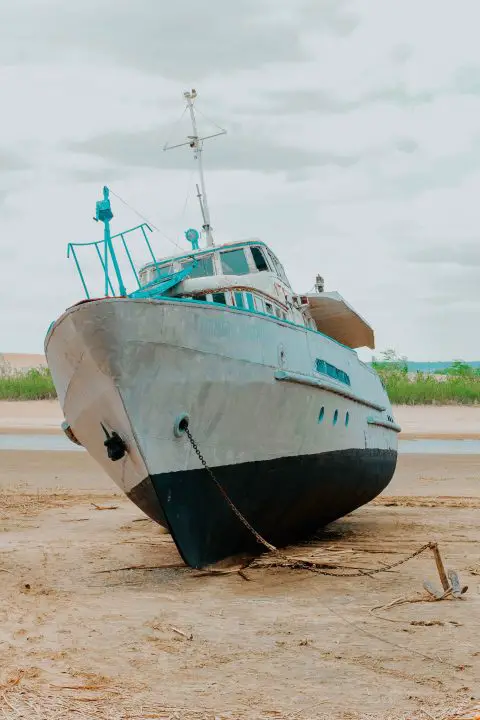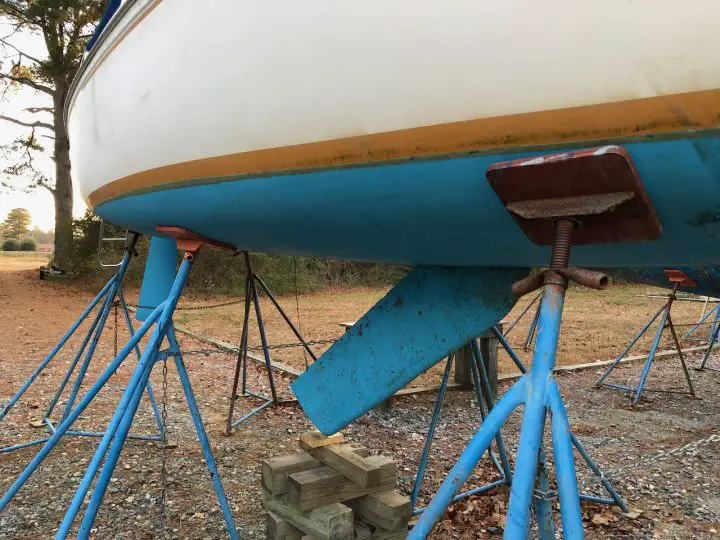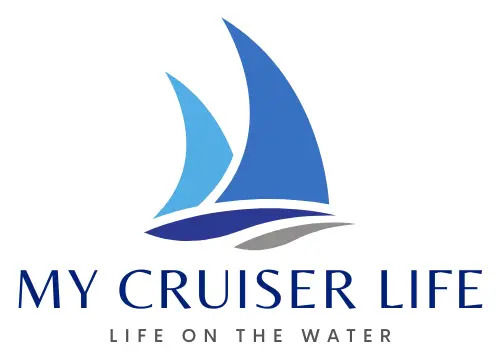If you run your boat in water that is too shallow, you will run aground. This simple fact is obvious to even non-boaters.
But what a complex concept! How do you know how shallow your boat can go? How do you even know how deep the water is where you are, or how deep a boat sits in the water? These are simple questions for experienced boaters, but beginners have a serious learning curve.
As long as there is more water depth than the draft of your boat, you’re good to go. The draft of a boat is a measurement provided by the manufacturer and is how deep it sits below the water.
So let’s take a look at the not-so-simple art of not running aground.

Table of Contents
- Don’t Run Aground — Know the Minimum Water Depth for Boat
- How Do You Know the Water Depth?
- Types of Draft on a Boat
- Considerations for a Fixed Dock, Floating Dock, and Boat Lift
- Keep It Afloat, Skipper
- FAQs (Frequently Asked Questions)
Don’t Run Aground — Know the Minimum Water Depth for Boat
The first step to keeping off the bottom is knowing the minimum water depth for your boat. The boat’s draft is an excellent place to start.
The draft of a boat is how deep it sits below the water. A sailboat with a deep keel has a deep draft—something like six feet or more. Most powerboats have drafts under two feet.
So, how deep does the water need to be for a boat? It needs to be more than the draft. As long as there is more water depth than the draft of your boat, you’re good to go. Of course, operating with only inches to spare isn’t a great idea. A wave or boat wake could come along and pound you into the bottom—and that’s an excellent way to break something.
The amount of extra water depth you have under your keel at all times is a matter of personal preference. Some skippers are risk-averse and start sweating when there’s less than a foot or two of fudge factor. Others are much more relaxed about it, and as long as they’re floating, they’re fine.
How Do You Know Your Boat’s Draft?
A boat’s draft is a published specification, like its length, beam, or height above the water. Interestingly enough, the height above the water is sometimes called “air draft.” It’s a significant number to know when you’re approaching a fixed bridge and need to know if you can make it safely or not.
If you don’t know the draft of your boat, the best thing you can do is search the internet for the answer. It helps to be very specific since the draft is a design feature that changes from model to model. Even within one sailboat model, multiple keels with different drafts might be offered.
If you’ve recently acquired a boat and are trying to figure out her draft, go through all of the records you have. Many boaters keep manufacturer specifications, sales brochures, and other papers on board for decades. You might also find a survey handy—although many times surveyors are doing the best they can with limited information as well.
If you can’t find a reliable answer on the internet, your next option is to go out and measure your draft. This is easily done when the boat is out of the water. Just find the deepest part of the boat, and measure in a straight line downward from the waterline.
If you can’t take the boat out of the water, you might be able to get an idea by going for a swim with a tape measure. Depending on where you are and how clear and warm the water is, this might be easy. Regardless, the results will not be very accurate using this method, but it’s a start.

How Do You Know the Water Depth?
Knowing how much water your boat draws is step one. Step two is staying in water that is deeper than that at all times. There are two tools in your skipper’s toolbox to make that happen. First, always maintain situational awareness and navigate carefully. Second, use a depth sounder to check your work to ensure you have enough depth. Here’s how these things work together.
Situational Awareness and Navigation Skill
Driving a boat is unlike driving a car. In a car, you know the car will continue rolling and shouldn’t hit anything if you stay in the lanes on the highway. Any obstacles to your path will be clearly visible.
But a boat operates where there are no roads, and the obstacles that could hurt you may be invisible and underwater. To operate safely, you need to use a chart and know the area well. You need to study the chart and know where the deep water is and where any obstacles lay.
Then, you need to ensure that you keep your boat in those deep water, safe areas at all times. Doing that means you can’t just space out and head one way or another. It means you must maintain situational awareness—the knowledge of where you are and what hazards lie around you—at all times.
Situational awareness is a skill that you build up over time. Many tools help you learn it, including charts, chart plotters, GPSs, radars, and navigational markers on the water. But when discussing the art of not running aground, it is impossible not to mention the beautiful thing that is the modern depth sounder.
Depth Sounders to Know Actual Water Depth
There are two types of sounders on modern boats—simple sounders and sonars. A sounder is simply a digital depth gauge, while a sonar can display features on the bottom or even fish under that boat. Sonars are also called fish finders. Both can be used as tools to help you keep your keel off the bottom.
Both sounders and fish finders use the same technology. First, a transducer on the hull sends out ultrasonic waves that bounce off the bottom and reflect back to the transducer. Then, the equipment measures how long it takes the sound waves to come back.
The most important thing to know about a depth finder is that it must be calibrated. The equipment can only know the depth under the transducer. If the transducer is already two feet underwater on your keel, then the water will always be two feet deeper water than it reads. If your draft is five feet total, then you’ll be aground when the depth sounder reads three feet.
But you can remove all of these complications by simply calibrating the sounder. You can either tell it to add two feet to everything and then it will read the actual water depth. Then, you’ll be aground when the sounder reads five feet. Since you draw five feet, this makes sense. Keep your boat in places with more than five feet of water indicated on the charts and your sounder, and you’ll be golden.
Some people prefer instead to set their sounder to read the water depth under the keel. In other words, they want the sounder to read zero when they are aground. To do this in the example above, you would calibrate it to subtract three feet from every reading. However, this adds some confusion if you are looking at a chart and want to compare your depth soundings to those shown on the chart. Yours will always be five feet off.
If you have a newly acquired boat, make a point to find the settings on the depth sounder. Figure out what the last owner was doing, and set it in a way that makes sense to you.
- The most versatile handheld depth finder sonar system ever produced
Prices pulled from the Amazon Product Advertising API on:
Product prices and availability are accurate as of the date/time indicated and are subject to change. Any price and availability information displayed on [relevant Amazon Site(s), as applicable] at the time of purchase will apply to the purchase of this product.
Types of Draft on a Boat
The draft of a boat is not a static number. Even on a small boat, the draft will change a few inches depending on how it is loaded. For example, if you have a 16-foot skiff and you load it full of fuel and take three passengers, it will draw a few more inches than it does when you take it out alone.
The same concept is true on most boats. For example, on a massive cargo ship, the draft might change 20 or 30 feet from when the boat is fully loaded to when it is empty.
Minimum vs Maximum Draft
Some sailboats list minimum and maximum draft numbers. This is the case when a boat has a variable keel. There are several designs, including centerboards, daggerboards, lifting keels, and swing keels. The purpose of these designs is to operate in shallow waters with their keel up while maintaining good sailing characteristics with the keel down.
What is the minimum draft on a boat? The minimum is when all the boards or keels are fully raised, and the boat is lightly loaded. This point is the “best-case scenario”—the absolute least amount of water the boat can float in. On the other hand, the maximum draft is the “worst-case scenario”—the absolute deepest draft it could have with the keel all the way down.
Static vs Running Draft in Shallow Water
Many powerboats have adjustable sterndrives or outboards that can affect their minimum and maximum drafts. Outboards can often be lifted out of the water—but of course, they cannot operate when they do. Still, outboards are common on flats skiffs that draw only an inch or two of water with the motor up. The operator can then use a pole or oar to maneuver over sand flats.
Powerboats have another consideration, though. A planning hull will lift out of the water when running, meaning that its maximum draft occurs when standing still or static. Static draft refers to this number while running draft refers to how much water it needs when on a plane. Running draft usually isn’t much more than the depth of the motor’s lower unit and a tiny sliver of the hull’s design.
Considerations for a Fixed Dock, Floating Dock, and Boat Lift
You might be wondering how all of this ties into docks at homes or marinas. Is there a particular depth that you can always be assured of next to a dock? How deep does the water need to be for a floating dock?
Well, the truth is you can never be sure of water depth simply by the presence of a dock. If you’re in a deep draft sailboat, you might be looking at a nice dock made for shallow-draft skiffs. Or you might be looking at a floating dock that a marina installed before the entire place shoaled in.
When approaching a dock for the first time, it’s best to ask whoever is in charge. Dockmasters at marinas should know where the shallow spots are. Make sure they know how deep your draft is, and specifically ask them if there are any spots you need to avoid.

Keep It Afloat, Skipper
Depending on how fast you do it and what the bottom is made of, running aground can be a minor inconvenience to a deadly accident. Situational awareness, careful operating, and solid navigation are all tools every skipper must focus on to keep themselves off the bottom.
If ever you’re out there, and it’s looking bad, remember this one last piece of advice—go slow. Bad things that happen slowly are usually much less bad than bad things that happen quickly.
FAQs (Frequently Asked Questions)
How deep does the water need to be for a boat?
Every boat design has a different draft. The draft of a boat is a measurement of how deep its hull and keel sit below the waterline. To float, the water depth must be greater than the boat’s draft. Powerboats usually have drafts of around two feet, while sailboats usually have deeper keels and need six feet or more to float.
How do you know how shallow your boat can go?
To float, you need to stay in water deeper than your draft. Therefore, the draft of your boat is a critical specification that you should know. If you don’t know it, you can physically measure it or look up the specifications for your boat on the internet. The boat’s draft varies, depending on whether you have the motors up or down or if the boat has a retractable centerboard. Weight also matters—a heavier boat will have a deeper draft. If you’re using a depth sounder to figure out how shallow your boat can go, it’s critically important to understand how the sounder is calibrated. The sounder can only measure the depth below its transducer, mounted anywhere on the hull below the waterline. Therefore, it can be calibrated to read depth below the transducer, below the keel, or show actual water depth from the waterline.
What is minimum draft on a boat?
The minimum draft is a specification referring to the least amount of draft a boat can have. In many cases, it is the same number as the maximum draft. In other words, not much on the boat can change the draft. In the case of a swing keel or centerboard boat, the minimum draft refers to the draft when the keel or board is drawn up. Maximum draft refers to the draft when the keel or board is fully extended. On powerboats with stern drives or outboards, the same numbers mean when lower units are fully down versus rigged for shallow running. The minimum draft can also refer to the boat’s draft when lightly loaded. Larger boats ride lower in the water when fully loaded, and therefore have deeper drafts. The draft of a cargo ship, for example, changes by as much as 20 or 30 feet between being empty and fully laden.
How deep does the water need to be for a floating dock?
Floating docks can sit in any amount of water, and most designs allow them to dry out completely. In areas of significant tidal ranges, it’s not uncommon to see floating docks sitting in the mud during low tide and floating in ten feet of water at high tide. Of course, this means that the limiting factor is that of the boats tied to the dock. A floating dock is not strong enough to support the weight of a boat, so any vessels tied to the dock must remain floating.


